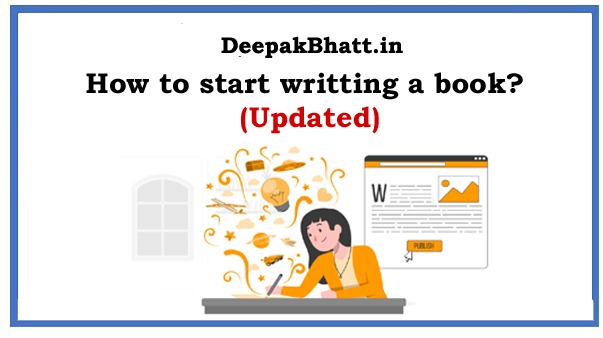How to start writting a book Starting to write a book can be an exciting and intimidating process.
Here are some general steps you can follow to get started:
What is blog? blog writing Free
How To Become a Singer? Free Information
How to become Actor? Start Becoming Big Actors
How to start writting a book
1. Identify your book’s topic:
Think about what you want to write about. Consider your interests, expertise, and what you want to share with the world.
To identify your book’s topic, consider the following:
- Your interests: Think about topics that interest you or that you are passionate about. This can help you stay motivated and engaged throughout the writing process.
- Your expertise: Consider topics that you have expertise in or that you have a unique perspective on. This can help you write with authority and credibility.
- Reader interest: Think about what topics are popular or in demand among readers. Research current trends and bestselling books to get ideas.
- Gaps in the market: Consider topics that are not well covered in existing books or that have not been explored in-depth. This can help you differentiate your book and attract readers.
What is Blog Marketing? Complete Detail
Blogging for Beginners Free Video Course
How to Analyze Content for Blog Marketing
2. Determine your target audience:
Who do you want to read your book? Consider their age, gender, occupation, interests, etc.
To determine your target audience, consider the following:
- Demographics: Think about the age, gender, education level, and geographic location of your potential readers. These factors can help you understand their needs, interests, and preferences.
- Interests: Consider the topics, genres, and themes that your potential readers are interested in. This can help you choose a topic that resonates with them and write in a style that appeals to their preferences.
- Reading habits: Think about the reading habits of your potential readers. Do they prefer print or digital books? Do they have a lot of time to read, or are they busy with other activities?
- Purpose: Consider why your potential readers might be interested in your book. Are they looking for information, entertainment, or inspiration? Understanding their purpose for reading can help you write content that meets their needs.
3. Develop an outline:
Create an outline that outlines the structure of your book. This can help you organize your thoughts and ensure that your book flows logically.
Here are some tips for developing an outline:
- Start with a working title: Your working title should give an idea of what your book is about and help you focus your ideas.
- Identify your main ideas and themes: Think about the main ideas and themes that you want to explore in your book. Write down these ideas and organize them into categories.
- Create a table of contents: Use your main ideas and themes to create a table of contents. This will give you a high-level overview of the structure of your book.
- Break down each chapter: For each chapter, create a sub-outline that breaks down the content into smaller sections or topics. This will help you organize your ideas and ensure that each chapter has a clear focus.
- Consider pacing and flow: Think about the pacing and flow of your book. Consider how you will transition between chapters and how you will keep the reader engaged.
- Review and revise: Once you have a draft outline, review it and make revisions as necessary. Consider the feedback of beta readers or critique partners to refine your outline and ensure that your book is well-structured and engaging.
4. Set a writing schedule:
Set aside regular writing time and stick to it. This can help you make progress and avoid procrastination.
Here are some tips for setting a writing schedule:
- Determine your writing goals: Before you set a schedule, determine your writing goals. Consider how much time you can realistically commit to writing each day or week, and how much progress you want to make on your book within a given timeframe.
- Choose a consistent time and place to write: Choose a consistent time and place to write that works for your schedule and your writing process. This might be early in the morning, during your lunch break, or in the evening after work. Choose a quiet and comfortable place where you can focus and avoid distractions.
- Block off writing time in your calendar: Treat your writing time as an appointment and block it off in your calendar. This will help you prioritize your writing and ensure that you have dedicated time to work on your book.
- Set a daily or weekly writing goal: Set a specific writing goal for each writing session, such as writing for a certain number of minutes or writing a certain number of words. This will help you stay focused and make progress on your book.
- Be flexible: Be flexible with your schedule and adjust it as needed to accommodate changes in your life or writing process. Don’t be too hard on yourself if you miss a writing session, but also be disciplined about getting back on track.
5. Start writing:
Begin with a strong opening that captures the reader’s attention. Focus on writing a first draft without worrying about perfection. You can always revise later.
Here are some tips to help you get started:
- Start with the easiest section: Sometimes it’s helpful to start with the easiest section of your book to get the words flowing. This might be the introduction or a chapter that you feel particularly excited about.
- Write a rough draft: Don’t worry about making your writing perfect right away. Just focus on getting your ideas down on paper. You can always revise and edit later.
- Set a daily or weekly word count: To help you stay on track, set a daily or weekly word count goal. This will help you make steady progress and ensure that you reach your writing goals.
- Write in short bursts: If you’re struggling to find time to write, try writing in short bursts. Even 10-15 minutes of writing can add up over time.
- Turn off distractions: When you’re ready to write, turn off all distractions, such as your phone or email notifications. This will help you focus and be more productive.
- Use a timer: Set a timer for a specific amount of time and write until the timer goes off. This can help you stay focused and prevent procrastination.
6. Revise and edit:
Once you have a complete draft, revise and edit it several times. Consider asking others for feedback to improve your book.
Here are some tips for revising and editing your book:
- Take a break: After you have completed your rough draft, take a break from your book for a few days or even a week. This will help you come back to your book with fresh eyes and a clear mind.
- Read your book out loud: Reading your book out loud can help you identify awkward phrasing, typos, and other errors that you might have missed while reading silently.
- Focus on the big picture first: Start by reviewing the big picture elements of your book, such as the plot, characters, pacing, and themes. Make sure these elements are working together to create a cohesive and compelling story.
- Edit for clarity and concision: Once you have reviewed the big picture elements of your book, focus on editing for clarity and concision. Make sure your sentences and paragraphs are clear and easy to understand, and remove any unnecessary words or phrases.
- Check for grammar and spelling errors: After you have revised for content and clarity, check your book for grammar and spelling errors. You can use tools like spell check or grammar check, but be sure to also read through your book carefully to catch any errors that might slip through the cracks.
- Get feedback: Once you have completed your revisions, it’s a good idea to get feedback from beta readers, a writing group, or a professional editor. This can help you identify areas of your book that might still need improvement and give you ideas for further revisions.
7. Consider publishing options:
Decide whether you want to self-publish or seek a traditional publisher. Research the options available to you.
Here are some options to consider:
- Traditional publishing: This involves finding a literary agent who will represent you to a traditional publishing house. The publishing house will then take care of editing, designing, and distributing your book. While this can be a challenging process, traditional publishing can offer wider distribution and greater prestige.
- Self-publishing: With self-publishing, you are responsible for editing, designing, and distributing your book. You can publish through online retailers like Amazon or Barnes & Noble, or you can print physical copies of your book yourself. Self-publishing can offer more creative control and higher royalties, but it also requires more work and investment on your part.
- Hybrid publishing: Hybrid publishing is a combination of traditional and self-publishing. You pay a fee to a hybrid publisher who will help with editing, design, and distribution, while also offering more creative control and higher royalties than traditional publishing.
- Small press publishing: Small press publishers are independent publishers that specialize in niche or literary genres. They can offer more personalized attention and creative control than traditional publishers, but they may have more limited distribution.
Remember, writing a book is a long process that requires patience and persistence. Stay committed to your goal, and you will eventually complete your book. Good luck!
Welcome all of you to my website. I keep updating posts related to blogging, online earning and other categories. Here you will get to read very good posts. From where you can increase a lot of knowledge. You can connect with us through our website and social media. Thank you







